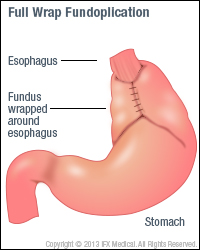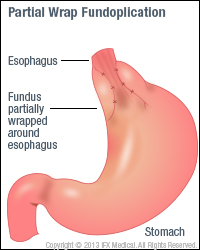Dr. Bagnato is an expert in advanced laparoscopic reflux surgery for treating gastroesophageal reflux disease (GERD) and associated problems such as hiatal hernia.
The standard surgical treatment for gastroesophageal reflux disease is called a fundoplication. This procedure is intended to strengthen the muscular barrier where the stomach and esophagus join called the lower esophageal sphincter (LES).
During the operation, the top of the stomach, the fundus, is wrapped around the lower end of the esophagus and sewn into place. The stomach can be wrapped entirely around the esophagus as in the Nissen Fundoplication or partially wrapped as in the Hill Posterior Gastropexy.


Once complete, the stomach’s muscular wall creates additional pressure on the lower part of the esophagus. It helps reduce the reflux of stomach acid.
Dr. Bagnato was among the first surgeons to perform laparoscopic Nissen fundoplication (a procedure used to treat acid reflux and repair a hiatal hernia) and laparoscopic removal of gallstones lodged in the common bile duct.
About Laparoscopic Reflux Surgery
Because it is performed through small incisions, laparoscopic or minimally invasive surgery is often referred to as bandaid, keyhole, or pinhole surgery.
Laparoscopic surgery offers many benefits, including:
- Less discomfort because the surgical incisions are much smaller
- Faster recovery times
- Shorter hospital stays
- Earlier return to full activities
- Smaller scars than traditional surgery
- Reduced blood loss and less internal scarring
- Reduced risk of infection
In conventional surgery, incisions are made through the skin and muscle layers. These incisions are large enough for the surgeon to see the area to be operated on and to perform the procedure using one or both hands.
With laparoscopic surgery, the incisions are very small, usually only half an inch in length. Instead of using his hands directly, Dr. Bagnato inserts a long flexible tube called a laparoscope through the tiny incision. The laparoscope is attached to a video screen and allows Dr. Bagnato to perform the operation while looking at the operation area on the screen. Because the operation area can be magnified greatly on the screen, tiny structures can be seen easily allowing extremely precise control during the procedure.
Using thin instruments passed through the laparoscope, the entire operation can be performed without the traditional large incision of an open procedure.


